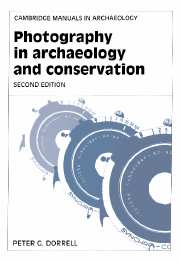Book contents
- Frontmatter
- Contents
- List of illustrations
- Preface
- Preface to the second edition
- Acknowledgements
- 1 The early days of archaeological photography
- 2 Basic principles and practice
- 3 Equipment
- 4 Lighting by flash
- 5 Photographic materials, processing and printing
- 6 Architecture and standing monuments
- 7 Survey photography
- 8 Site photography
- 9 Principles of object photography
- 10 Principles of close-up photography
- 11 Ultra-violet and infra-red photography
- 12 Photographing finds
- 13 Flat copy
- 14 Preparation of material for publication
- 15 The future
- References
- Index
4 - Lighting by flash
Published online by Cambridge University Press: 23 December 2009
- Frontmatter
- Contents
- List of illustrations
- Preface
- Preface to the second edition
- Acknowledgements
- 1 The early days of archaeological photography
- 2 Basic principles and practice
- 3 Equipment
- 4 Lighting by flash
- 5 Photographic materials, processing and printing
- 6 Architecture and standing monuments
- 7 Survey photography
- 8 Site photography
- 9 Principles of object photography
- 10 Principles of close-up photography
- 11 Ultra-violet and infra-red photography
- 12 Photographing finds
- 13 Flat copy
- 14 Preparation of material for publication
- 15 The future
- References
- Index
Summary
This chapter deals with the equipment for flash lighting and with its general use. Equipment and methods are more or less similar in every situation, but some particular applications are discussed under the relevant headings elsewhere. A comprehensive account of flash equipment can be found in Langford (1989) and of its use in the field in Blaker (1976).
Types of equipment
Bulb or expendable flash is nowadays little used largely because of the high cost for each exposure and the inconvenience of carrying a supply of bulbs. The exception is when it is necessary to light a large interior from several points simultaneously, when the relative simplicity of arranging a long firing-circuit, and the availability of high-output bulbs, become invaluable.
The construction of the bulbs themselves is simple enough. The bulb contains a fine foil of magnesium/aluminium (or, for small bulbs, zirconium) in an oxygen-enriched atmosphere. A small wire filament in the centre of the bulb ignites the foil when a current of 3 V or more is passed through it. Bulbs are available in several sizes, giving a wide range of light output, from the small ‘Magicube’ bulbs fitted to snapshot cameras, with a peak light output of less than 500,000 lm to the largest ‘S-type’ bulbs, with an output in excess of 5,000,000 lm.
- Type
- Chapter
- Information
- Photography in Archaeology and Conservation , pp. 54 - 64Publisher: Cambridge University PressPrint publication year: 1994



